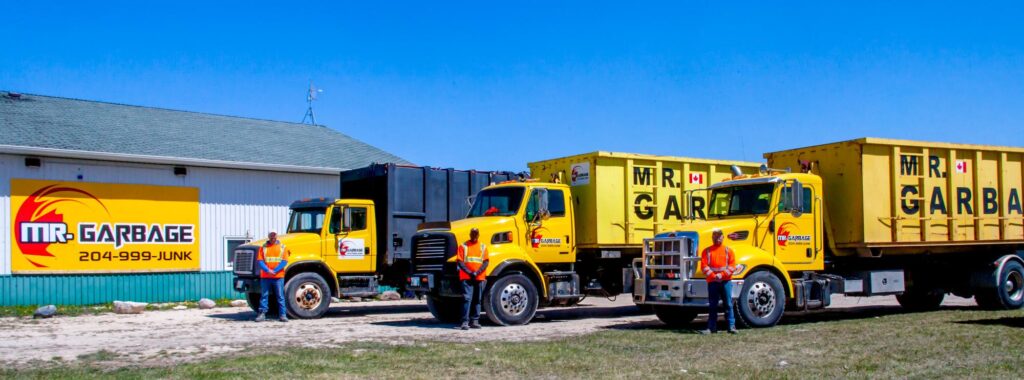If you’re planning a renovation, major cleanout, or landscaping project in northern Winnipeg, a 30-yard roll-off dumpster is a practical, low-hassle way to collect and remove bulk waste. This guide walks you through everything homeowners need to know: what a roll-off dumpster is, why a 30-yard container is a popular choice, how to prepare your site for delivery, the City of Winnipeg permit and placement rules, what should and should not go in the bin, and how to maximize recycling and diversion.
You’ll also find local examples, a short decision checklist to pick the best option for your job, and clear next steps if you want Mr. Garbage to manage delivery, staged pickups, and responsible routing to local recyclers and depots.
What is a 30-yard roll-off dumpster, and why consider one in northern Winnipeg?
A 30-yard roll-off dumpster in northern Winnipeg refers to a large, open-top container that is delivered and removed by a roll-off truck. In practical terms, a 30-yard bin offers a large internal volume while remaining narrow enough to fit most residential driveways and service lanes — a reason many homeowners choose this size for whole-room renovations, major cleanouts, and project demolition. Why homeowners prefer a 30-yard roll-off dumpster:- It reduces the number of trips to transfer stations.
- It works well for mixed renovation debris and bulky items.
- The footprint typically fits residential driveways while offering substantial capacity.
How the truck and delivery work
Understanding the truck’s needs is the single best way to avoid delivery problems.What drivers need to deliver a 30-yard bin
- Straight approach and turning room: roll-off trucks are long. Confirm there’s enough space for the truck to back in or make the turn.
- Overhead and lateral clearance: check for low branches, power lines, awnings, or gates that could block the truck or the raised dumpster.
- Solid surface for placement: Trucks and loaded dumpsters are heavy. A firm driveway (or protective boards under the bin) avoids rutting or surface damage.
Placement rules and permits
Where the dumpster sits affects whether you need a permit.Private property vs public right-of-way
- If the dumpster sits fully on private property (driveway, private parking area), a city permit is usually not required.
- If any portion of the bin occupies the boulevard, sidewalk, or street, City of Winnipeg street-use rules typically apply, and a permit will be needed. The City’s permits pages explain public-space permissions and best practices. City of Winnipeg
What to load; accepted and prohibited materials for a 30-yard roll-off dumpster
Knowing what to put in the bin avoids rejected loads and disposal delays.Commonly accepted materials
- Non-hazardous construction debris: drywall, framing, flooring, cabinets.
- Bulky household items: furniture, mattresses (check local charity options first).
- Mixed household waste tied to renovation or cleanout work.
Items that need special handling
- Electronics and many batteries: take to 4R depots (Brady, Pacific, Panet) for e-waste processing. City of Winnipeg
- Hazardous household products (paints, solvents, pesticides): bring to hazardous-waste programs at local depots. City of Winnipeg
- Refrigerant-containing appliances (fridges, ACs): refrigerant must be recovered by certified technicians before disposal.
- Asbestos and other regulated hazardous building materials require licensed abatement and special disposal; never put these in a standard roll-off.
How to prepare your site and the bin for efficient loading
Small steps before delivery make the job smoother.Staging and loading tips
- Clear a direct path to the drop location and remove parked vehicles for delivery day.
- Protect driveway surfaces with plywood or timbers if needed.
- Break down large items where safe (disassemble furniture, cut large panels) to maximize space.
- Separate metals, clean wood, and cardboard for recycling rather than mixing everything into the bin.
Recycling, diversion, and local depot options in Winnipeg
Using a 30-yard roll-off dumpster in Northern Winnipeg is efficient, but dividing streams boosts recycling.Local recycling and depot resources
Winnipeg operates 4R depots (Brady, Pacific, Panet) that accept electronics, household hazardous waste, scrap metal, and materials that shouldn’t go into general waste loads. Using depots for these special streams improves diversion and avoids regulatory problems. City of Winnipeg Practical approach:- Pull metals and clean wood out of the general load for separate recycling.
- Take e-waste and hazardous items directly to the depot rather than risking bin contamination.
- Donate reusable furniture or fixtures; many local charities will accept items in good condition.
Common problems with roll-off dumpsters and how to avoid them
Anticipate these to keep your project moving.Top issues and fixes
- Blocked delivery access. Fix: Confirm approach and clear vehicles before delivery.
- Overweight or prohibited materials. Fix: declare heavy items and remove banned items before pickup.
- Damage to lawns or driveways. Fix: request pads or plywood and position the bin on the firmest possible surface.
- Permit interruptions for street placement. Fix: plan placement early and ask your hauler to apply for permits if needed.
Pricing and billing transparency (what to expect)
While this article avoids listing fees, it’s helpful to understand billing factors so you can compare providers sensibly.Typical billing components to ask about
- Rental period and what happens if you keep the bin longer than planned.
- Whether disposal fees are charged by weight at the transfer station, and how heavy items are handled.
- Any extra charges for contaminated or prohibited materials, or for special handling of heavy debris.
- Whether the hauler will arrange permits if the dumpster sits on public property.
Mr. Garbage’s role in northern Winnipeg
Local experience matters for permit navigation, depot routing, and on-time delivery.What Mr. Garbage does for northern Winnipeg homeowners
- Site assessments to confirm truck approach and bin footprint fit.
- Guidance on what to separate for recycling and which materials must go to 4R depots.
- Help with permit coordination when street placement is unavoidable.
- Staged pickups for longer projects and documentation of disposal routing when requested.
Real homeowner examples: how a 30-yard bin solves common projects
Whole-kitchen remodel (example)
A homeowner replacing cabinets and flooring chose a 30-yard roll-off dumpster to hold cabinetry, drywall, and old flooring. The crew separated metal and cardboard for recycling and placed bulky electronics and hazardous cleaners at the 4R depot.Basement cleanout and estate clearance (example)
A house full of furniture and boxes used a 30-yard bin for the main removal. Reusable furniture was donated; electronics and batteries were dropped off at the depot. A single large bin removed the bulk of the work in one visit, leaving the house ready for staging.Exterior tear-off and landscaping (example)
A roof or landscaping project that produces long, heavy material combined a 30-yard bin with short, staged pickups to keep the driveway clear and ensure heavy materials were spread evenly within the bin. These practical examples show why a 30-yard option often hits the middle ground between capacity and driveway fit for northern Winnipeg homes.Decision checklist: Is a 30-yard roll-off dumpster right for your job?
Use this quick checklist:- Do you produce mixed renovation debris or multi-room cleanout waste? If yes, a 30-yard bin is likely suitable.
- Can your driveway or delivery area fit a 30-yard footprint and allow truck access? Measure and confirm.
- Are there heavy materials (concrete, brick, tile)? Declare them first to your hauler.
- Will the bin sit on private property or require a street permit? If public space is involved, plan permitting.
- Can you separate metals, clean wood, and e-waste before loading? Plan depot trips for those streams.
Final notes on safety, insurance, and resale
Permits and documentation matter beyond the cleanup.- Keep receipts and disposal documentation; they help with insurance claims and add transparency for potential buyers.
- Proper disposal of hazardous materials keeps you compliant and protects neighbours.
- Hiring licensed crews for appliance refrigerant recovery or asbestos handling protects you legally and physically.

